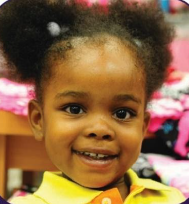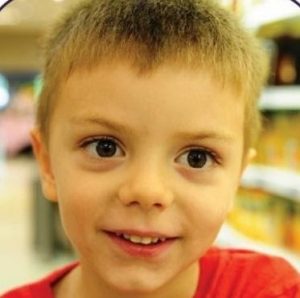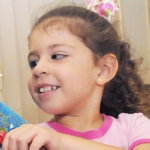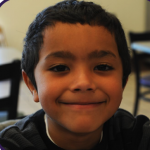Introduction to Planning for Preschoolers
Learning Objectives
What Preschoolers are Like
In order to plan for children it is vital to begin with one aspect of developmentally appropriate practice, which relates to the developmental characteristics of children based on their age. Here are some representations of what children are like at each age in the preschool years.
 This is 2-year-old Aniyah. She can run and walk up and down stairs while holding on. She prefers using her right hand and makes lines and circles when she draws. She is getting better at feeding herself. She loves completing sentences in her favorite books and can match real life objects to those in books. She knows the names of body parts and follows simple instructions. She speaks in 2 to 4 word sentences and will repeat words she hears. She gets excited when around other children. She can be defiant and is showing increasing independence.
This is 2-year-old Aniyah. She can run and walk up and down stairs while holding on. She prefers using her right hand and makes lines and circles when she draws. She is getting better at feeding herself. She loves completing sentences in her favorite books and can match real life objects to those in books. She knows the names of body parts and follows simple instructions. She speaks in 2 to 4 word sentences and will repeat words she hears. She gets excited when around other children. She can be defiant and is showing increasing independence.
 Tanner is three years old. He rides a tricycle, kicks a ball, and throws a ball overhand. He turns pages in book one at a time and can build a tower of more than 6 blocks. He loves simple puzzles and playing make believe with his toys animals. He can follow two- to three-step instructions. Most of the time strangers can understand him. He now separates easily from his parents. He is learning to take turns during games. He can get upset with big changes in his routine.
Tanner is three years old. He rides a tricycle, kicks a ball, and throws a ball overhand. He turns pages in book one at a time and can build a tower of more than 6 blocks. He loves simple puzzles and playing make believe with his toys animals. He can follow two- to three-step instructions. Most of the time strangers can understand him. He now separates easily from his parents. He is learning to take turns during games. He can get upset with big changes in his routine.
 Four-year-old Isabella catches a bounced ball and can stand on one foot for two seconds She c n pour from a small pitcher. She uses scissors and has begun to copy some capital letters. She names some colours and numbers. She has begun to play board and card games. She has a sound understanding of the basic rules of grammer and can sing familiar songs from memory. She knows her first and last name. She enjoys doing new things and cooperating with other children. She struggles to distinguish real from make-believe.
Four-year-old Isabella catches a bounced ball and can stand on one foot for two seconds She c n pour from a small pitcher. She uses scissors and has begun to copy some capital letters. She names some colours and numbers. She has begun to play board and card games. She has a sound understanding of the basic rules of grammer and can sing familiar songs from memory. She knows her first and last name. She enjoys doing new things and cooperating with other children. She struggles to distinguish real from make-believe.
 Mateo is five years old. He can skip and do a somersault. He loves swinging and climbing. When he draws a person it has six body parts. He prints his name and some other letters and numbers. He can count more than ten objects. He speaks very dearly in sentences of more than five words. He loves to tell stories. He is aware that he is a boy. He now understands what is real and what is make-believe.
Mateo is five years old. He can skip and do a somersault. He loves swinging and climbing. When he draws a person it has six body parts. He prints his name and some other letters and numbers. He can count more than ten objects. He speaks very dearly in sentences of more than five words. He loves to tell stories. He is aware that he is a boy. He now understands what is real and what is make-believe.
The rest of the chapter is very California heavy.

